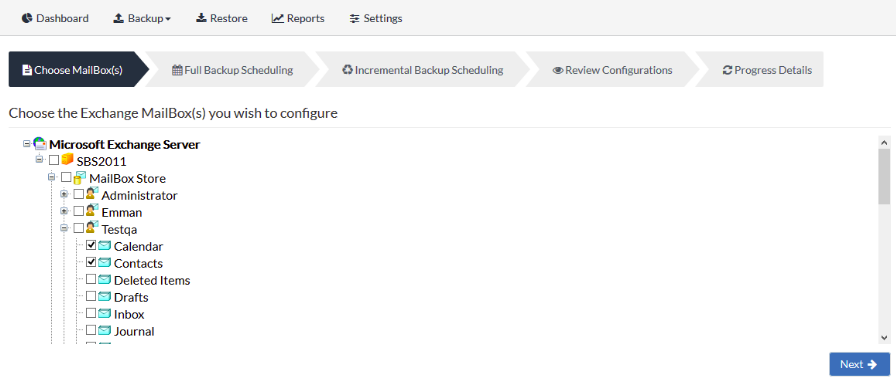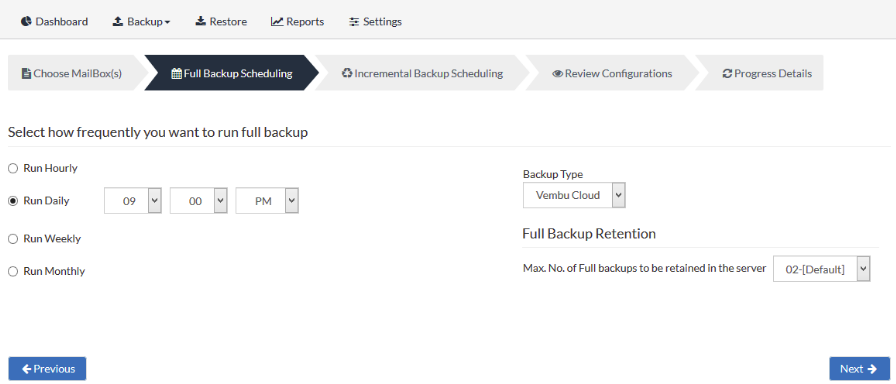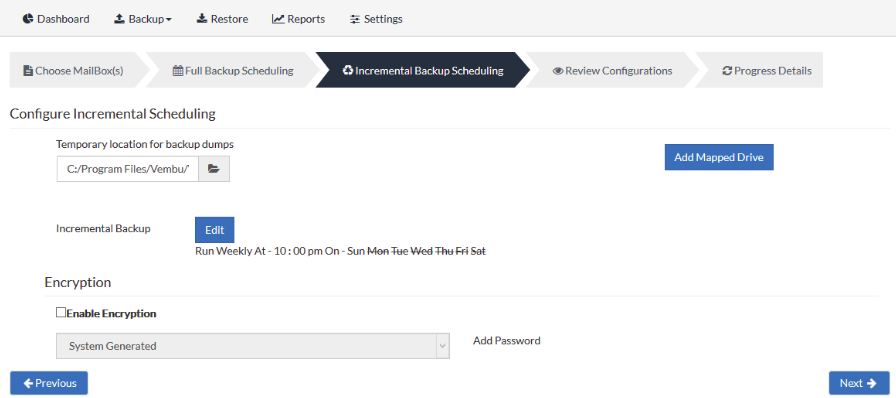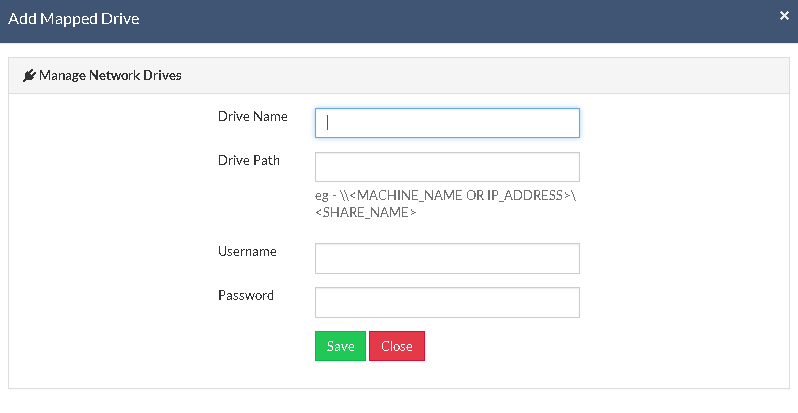Configure Backup Job
MS Exchange Mailbox plugin backup is a folder level backup, where users can either backup a mailbox of a specific user on the whole or can perform backup on a folder and subfolder level. In order to configure Exchange Mailbox backups, BDRCloud Client should be installed on machines where exchange servers are installed and if multiple Exchange servers are used, The BDRCloud Client should be installed on each machine.
The backed-up information(User Mailbox, folder, and subfolder) is stored in separate PST files. Exchange Mailbox is not an alternative to Exchange server backup, instead, it provides optional granularity for data to be backed up. This will be most helpful when a user is in need to recover an individual mailbox or its information(Such as contacts, emails, calendar, tasks, etc.) instead of recovering an entire server.
Note: Exchange Mailbox cannot act as a stand-alone solution for restores performed after a disaster and MS Exchange server restore is most helpful for such scenarios.
In the BDRCloud Client, navigate to the Backup tab Select MS Exchange Mailbox to begin the backup process.
Step 1: Configuring Mailbox

- On this page, the list of users and their corresponding Mailboxes, the folders, and sub-folders that are available in the Exchange Server will be listed in a tree format. From the list, select the required Mailbox, folders, or the sub-folders that are to be backed up. The mailboxes will be retrieved and listed with the help of the MAPI plugin tool. Click Next to continue with the backup process.
Note: The Cloud BDR Client should be running in the machine where Exchange Server is installed to create Exchange Mailbox backups. If multiple Exchange Servers are used, then BDRCloud Client should be installed in all of them.
Step 2: Configure Full Backup Scheduling
Users can configure their backup schedules flexibly based on their requirements. They can choose from Hourly/Daily/Weekly options for backup schedules.

- Run Hourly- This option will let the user run full backup in hourly time intervals. A user can select the weekdays and time interval between backup schedules.
- Run Daily- This option will let the user run a full backup once a day and the user can specify the time at which full backups should run every day.
- Run weekly- This option will let the user run a full backup once a week and the user can specify the day and time of their choice when to perform full backups in a week.
- Run Monthly- This option will let the user run a full backup once a month and the user can specify the day, time and month of their choice for full backup schedules.
Note: Run Monthly is the recommended and default configuration
Full Backup retention
You can specify the count for the maximum number of full backups to be retained. For example, when you set the count as 2 for retaining the full backups in the backup server, only the latest 2 versions of the full backup will be retained. The default value for full backup retention is ‘2’. Once done with scheduling full backups, proceed to the configure Incremental Backup by selecting Next.
Step 3: Configure the Incremental Backup Schedule

Temporary location for backup dumps
Enter the location/directory path in which the Exchange Mailbox dumps has to be temporarily stored before uploading to the backup server. Ensure you have enough disk space in the configured location(where the backup dump has to be saved).
Note: Backup dumps stored in temporary locations will be deleted once backup dumps are transferred successfully to the remote backup server
Incremental Backup Scheduling
The client will do an incremental backup dump of the user’s mailbox with respect to previous full or incremental backup, whenever an incremental log backup is scheduled.
Once enabled, the incremental backup option lists the following schedules to choose from:
- Run Weekly- Lets the user decides the time and day of a week when the backup should run. The client will execute the backup every week on the particular day and time chosen. Note that you can select multiple days of the week if you wish to run the backup more than once a week.
- Run Daily- Lets the user decides the time at which the backup should run daily. This will execute the backup every day at the user-specified time.
- Run Every Few Hours- This lets the user decides the hour frequency at which the backup schedule should be triggered. It also lets the user decide the days when the hourly schedules should be carried out.
Add Mapped Drive
There may be situations in which you may not have enough space to allocate for the dump process. In such cases, you can add a mapped drive by providing the drive name, drive path, username, and password. From there on the dumping process will happen to the configured drive only.
- The drive path must be in the following format: \\<MACHINE_NAME OR IP_ADDRESS>\<SHARE_NAME> make sure you give the correct details else you will get the status “Mapping the drive letter to the UNC path failed with the error: The network path was not found.”
- Ensure you provide proper credentials, if not the message “Mapping the drive letter to the UNC path failed with the error: The specified network password is not correct” will appear. Click Save to complete the process.
Note: If the drive you have configured already exists or you have already mapped that drive to a UNC path, you will get the following message “C:/ drive already exists or mapped to a UNC path. Please choose a different drive letter

Encryption Setting
Backups configured under BDRCloud client can be encrypted with a user-defined password which can be provided during backup configuration.
Steps to add Encryption Password
- In order to encrypt your backup, select Enable Encryption checkbox. You can either add your own password or encrypt the backup with a System Generated Password.
- To create a new password, click on Add Password. Provide the password of your choice along with a password hint and save it
- The newly created password will be available in the drop-down list. Choose the password and click Next. All the added passwords will be listed in the drop-down box. With the help of the encryption hint, you can easily identify the required password. Click Save once you have provided the required details.
Note: By default, BDRCloud Client uses the system-generated password to encrypt backups even if Encryption is disabled. You can opt for a custom password for extended data protection and you will be required to provide it during recovery. Opting to the custom password will disable the integrity check from being performed automatically. It is recommended to perform Quick VM Recovery periodically to ensure data integrity
Note: Password and its hint should not be the same to avoid security issues. The password should contain at least a character, a number and a special character [! @ # $ % ^ & *] .Encryption hint should be at least 6 characters and not more than 25 characters. Encryption hints are unique and no two passwords can have the same encryption hint
- Once done configuring the Encryption Password, Click Save.
Step 4- Review Configurations
The last step in the MS Exchange Mailbox backup configuration is to enter the backup schedule name. The Cloud BDR Client supports creating multiple backup schedules each with its own configuration. The backup schedule name will uniquely identify the backup. While restoring your backup data, you need to choose the data to be restored using its schedule name.
Review the configuration provided and enter an appropriate name for the backup schedule. Once done, click Save the Backup to initiate the backup progress as per the schedule configured and it gets completed successfully.
Note: While providing a backup name, only [a-z][A-Z][0-9][ – _ ] characters are allowed in the backup name. If you have configured a backup schedule with this name already, enter a different name for this backup job
